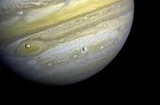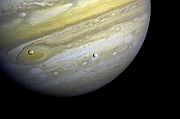
Redemption Cairn
Encyclopedia
Redemption Cairn is a science fiction
short story
by Stanley G. Weinbaum
that first appeared in the March 1936 issue of Astounding Stories. "Redemption Cairn" is the only Weinbaum story set on Europa
.
 In Weinbaum's Solar System
In Weinbaum's Solar System
, in keeping with the then-current "near-collision" hypothesis of planet
ary formation, Jupiter
radiates enough heat to create Earth-like environments on the Galilean moons
. Europa is airless except for a depression on the Jupiter-facing side of the tidally locked
moon, which holds a thin, but breathable atmosphere. This region is divided into a number of small valleys separated from each other by ridges rising above the atmosphere. The most widespread Europan species is the bladder bird, which carries its own air supply with it in an air sac, allowing it to cross over the airless peaks.
Sands' new co-pilot is Claire "The Golden Flash" Avery, whose sole qualification was winning the circumlunar Apogee race; more by sheer luck and suicidal risk-taking than by skill, in Sands' opinion. The other members of the expedition are the chemist Stefan Coretti and the biologist Gogrol.
Sands has proof of Avery's poor piloting ability during the landing on Europa, when he is forced to take over to prevent her from crashing the Minos. His suspicions are aroused when he realizes the crew of the Minos are doing no actual exploring.
One day, he and Avery return from gathering food to find Henshaw shot dead and Coretti wounded by Gogrol. The biologist forces the two pilots into the next valley and then crosses back over the airless ridge connecting them wearing an air helmet. He takes their helmets with him, so they can't follow. Avery then tells Sands the real purpose of the mission: Captain Gunderson of the Hera had discovered vast deposits of protactinium
on the previous expedition, and worked out a process for using it as a power source. Gunderson was lost in the crash, along with his notes, but it was hoped that he had left a copy behind on Europa. Now Gogrol has found the notes.
Gogrol returns because he needs one of them to pilot the ship to one of the human settlements on Io
. He shoots Sands in the leg and abducts Avery; when she passes out on top of the ridge, he picks her up and carries her, then tosses his pistol down to Sands with one shot left, so Sands can commit suicide. Instead, Sands shoots a native bladder bird and uses its air sac to keep breathing as he gives chase. He catches up to Gogrol in the darkened spaceship control room, finally recognizing him as Kratska. Sands sends Avery outside to retrieve Coretti; Kratska chooses that moment to attack Sands, but Sands manages to kill Kratska before passing out.
When Sands comes to, he is travelling in space aboard the Minos, which Avery has piloted to Io. Sands enters the control room in time to watch her make a perfect landing.
Science fiction
Science fiction is a genre of fiction dealing with imaginary but more or less plausible content such as future settings, futuristic science and technology, space travel, aliens, and paranormal abilities...
short story
Short story
A short story is a work of fiction that is usually written in prose, often in narrative format. This format tends to be more pointed than longer works of fiction, such as novellas and novels. Short story definitions based on length differ somewhat, even among professional writers, in part because...
by Stanley G. Weinbaum
Stanley G. Weinbaum
Stanley Grauman Weinbaum was an American science fiction author. His career in science fiction was short but influential...
that first appeared in the March 1936 issue of Astounding Stories. "Redemption Cairn" is the only Weinbaum story set on Europa
Europa (moon)
Europa Slightly smaller than Earth's Moon, Europa is primarily made of silicate rock and probably has an iron core. It has a tenuous atmosphere composed primarily of oxygen. Its surface is composed of ice and is one of the smoothest in the Solar System. This surface is striated by cracks and...
.
Weinbaum's Europa

Solar System
The Solar System consists of the Sun and the astronomical objects gravitationally bound in orbit around it, all of which formed from the collapse of a giant molecular cloud approximately 4.6 billion years ago. The vast majority of the system's mass is in the Sun...
, in keeping with the then-current "near-collision" hypothesis of planet
Planet
A planet is a celestial body orbiting a star or stellar remnant that is massive enough to be rounded by its own gravity, is not massive enough to cause thermonuclear fusion, and has cleared its neighbouring region of planetesimals.The term planet is ancient, with ties to history, science,...
ary formation, Jupiter
Jupiter
Jupiter is the fifth planet from the Sun and the largest planet within the Solar System. It is a gas giant with mass one-thousandth that of the Sun but is two and a half times the mass of all the other planets in our Solar System combined. Jupiter is classified as a gas giant along with Saturn,...
radiates enough heat to create Earth-like environments on the Galilean moons
Galilean moons
The Galilean moons are the four moons of Jupiter discovered by Galileo Galilei in January 1610. They are the largest of the many moons of Jupiter and derive their names from the lovers of Zeus: Io, Europa, Ganymede and Callisto. Ganymede, Europa and Io participate in a 1:2:4 orbital resonance...
. Europa is airless except for a depression on the Jupiter-facing side of the tidally locked
Tidal locking
Tidal locking occurs when the gravitational gradient makes one side of an astronomical body always face another; for example, the same side of the Earth's Moon always faces the Earth. A tidally locked body takes just as long to rotate around its own axis as it does to revolve around its partner...
moon, which holds a thin, but breathable atmosphere. This region is divided into a number of small valleys separated from each other by ridges rising above the atmosphere. The most widespread Europan species is the bladder bird, which carries its own air supply with it in an air sac, allowing it to cross over the airless peaks.
Plot summary
Jack Sands, the story's narrator, is a spaceship pilot down on his luck. In September 2111, he is about to be evicted from a flophouse when he is recruited by his old friend Captain Harris Henshaw to co-pilot an expedition to Europa. Sands is one of only two survivors of a previous visit to the Jovian moon. The other was his drug-addled co-pilot Kratska, who crashed the expedition's ship, the Hera, while landing it on Earth. While Sands lay unconscious in a hospital, Kratska put the blame for the crash on him, ruining his reputation. Kratska has since disappeared.Sands' new co-pilot is Claire "The Golden Flash" Avery, whose sole qualification was winning the circumlunar Apogee race; more by sheer luck and suicidal risk-taking than by skill, in Sands' opinion. The other members of the expedition are the chemist Stefan Coretti and the biologist Gogrol.
Sands has proof of Avery's poor piloting ability during the landing on Europa, when he is forced to take over to prevent her from crashing the Minos. His suspicions are aroused when he realizes the crew of the Minos are doing no actual exploring.
One day, he and Avery return from gathering food to find Henshaw shot dead and Coretti wounded by Gogrol. The biologist forces the two pilots into the next valley and then crosses back over the airless ridge connecting them wearing an air helmet. He takes their helmets with him, so they can't follow. Avery then tells Sands the real purpose of the mission: Captain Gunderson of the Hera had discovered vast deposits of protactinium
Protactinium
Protactinium is a chemical element with the symbol Pa and atomic number 91. It is a dense, silvery-gray metal which readily reacts with oxygen, water vapor and inorganic acids. It forms various chemical compounds where protactinium is usually present in the oxidation state +5, but can also assume...
on the previous expedition, and worked out a process for using it as a power source. Gunderson was lost in the crash, along with his notes, but it was hoped that he had left a copy behind on Europa. Now Gogrol has found the notes.
Gogrol returns because he needs one of them to pilot the ship to one of the human settlements on Io
Io (moon)
Io ) is the innermost of the four Galilean moons of the planet Jupiter and, with a diameter of , the fourth-largest moon in the Solar System. It was named after the mythological character of Io, a priestess of Hera who became one of the lovers of Zeus....
. He shoots Sands in the leg and abducts Avery; when she passes out on top of the ridge, he picks her up and carries her, then tosses his pistol down to Sands with one shot left, so Sands can commit suicide. Instead, Sands shoots a native bladder bird and uses its air sac to keep breathing as he gives chase. He catches up to Gogrol in the darkened spaceship control room, finally recognizing him as Kratska. Sands sends Avery outside to retrieve Coretti; Kratska chooses that moment to attack Sands, but Sands manages to kill Kratska before passing out.
When Sands comes to, he is travelling in space aboard the Minos, which Avery has piloted to Io. Sands enters the control room in time to watch her make a perfect landing.
Collections
"Redemption Cairn" appears in the following Stanley G. Weinbaum collections:- The Red PeriThe Red Peri (collection)The Red Peri is a collection of science fiction short stories by author Stanley G. Weinbaum. It was first published in 1952 by Fantasy Press in an edition of 1,732 copies...
(1952) - A Martian Odyssey and Other Science Fiction Tales (1974)
- The Best of Stanley G. Weinbaum (1974)
- Interplanetary Odysseys (2006)

